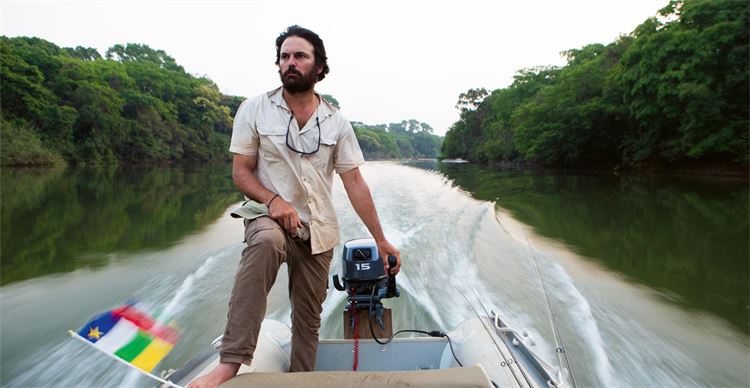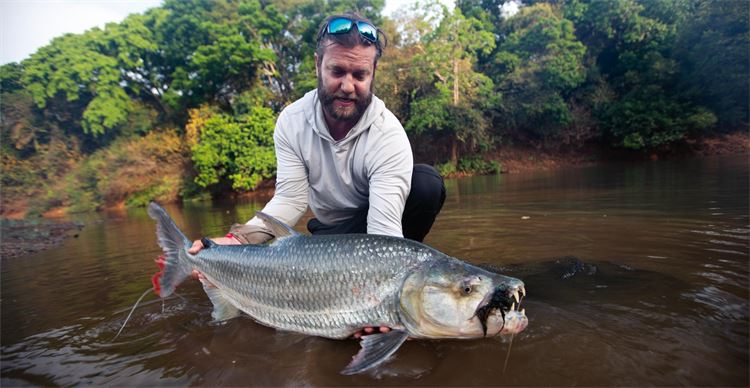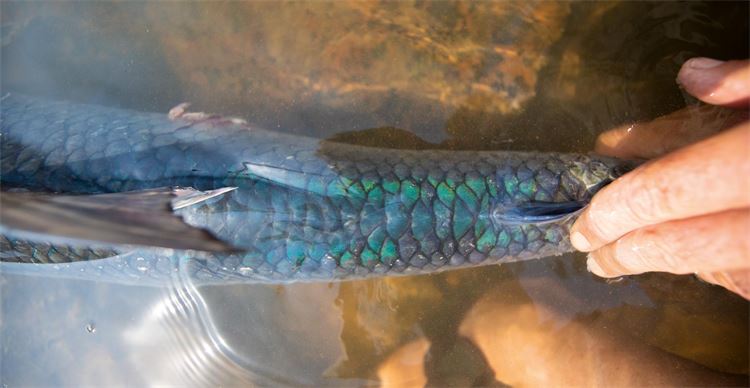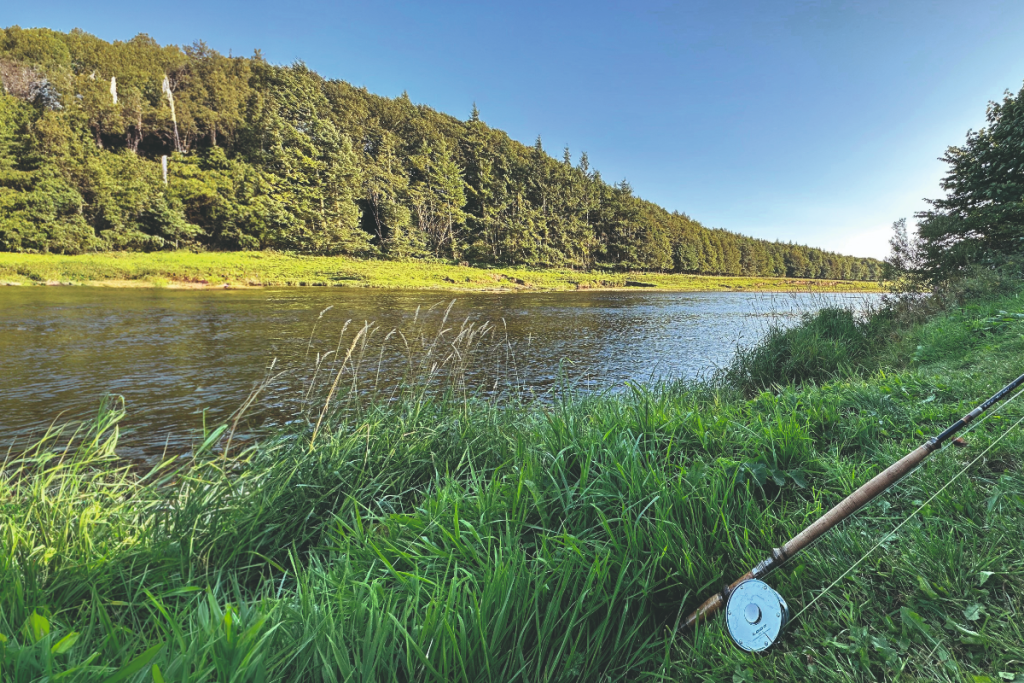Goliath tigerfish
Edward Ghaui & Francois Botha explore the unknown reaches of the Congo.

Forget it all. Forget everything you think you know about fly fishing in Africa. Now imagine a clear-flowing river hidden in the geographical centre of the continent, undisturbed by man and forgotten by the modern world, wending its way through an endless landscape of forests and savannahs over ancient, polished, volcanic rock. Lurking beneath the glassy surface is a fish that is believed to be incredibly difficult to find and impossible to catch on a fly. A fish both terrifying and beautiful at the same time.
Goliath tigerfish (Hydrocynus goliath) have captivated the minds of fishermen for centuries thanks to their sheer size and otherworldly aesthetics. It’s not surprising given these leviathans can weigh in excess of 100lb, have teeth an inch long, and are believed to feed not just on fish and aquatic mammals, but infant crocodiles and birds too. For my friend Francois Botha, goliath tigerfish have been an obsession since he first heard of them at the age of 17.
Goliaths have been an insatiable fascination for adventurous anglers and they have proved themselves to be tricky customers – not one fish has succumbed to the fly in over a century. The first rather large hurdle has been getting to the rivers they frequent in the Congo Basin. It involves travelling through Bangui – the capital city of Central African Republic (CAR) which has often suffered from both political and military strife since its foundation in 1889. Not only that, when you reach these pristine waters you are totally isolated, miles from civilisation and in a wild and dangerous habitat.
In 2014, a professional hunter (PH) working in a CAR game reserve spotted some huge silver fish whilst on an anti-poaching patrol. Knowing he would be interested, the PH mentioned his sighting to Francois who then wrote his last will and testament, hocked everything and boarded an aircraft to Bangui.
Francois finally landed his first goliath during that exploratory trip (after 17 years of plotting). He had achieved what many had claimed impossible. Not only did he capture the goliath on a fly, but he did so on a small, clear-running African river that was in a pristine state.
This sparked an even deeper passion in both Francois and me to return together to explore the perfect river in which to fish for goliaths – clean, clear, running water untouched by mining interests, deforestation, rebels or poachers.
We had the experience and the equipment necessary to get the ball rolling on an ecotourism venture. The civil war in CAR had fizzled out, the Lord’s Resistance Army was no longer considered a threat and concurrently the Chinko Project, an outstanding 20,000km2 wildlife refuge, was flourishing under the wing of African Parks. African Parks is a non-profit conservation organisation that takes on complete responsibility for the rehabilitation and long-term management of national parks in partnership with governments and local communities. They run the largest counter-poaching force and have the greatest area under the protection of any single NGO in Africa. They manage 15 national parks and protected areas in nine countries covering over 10½ million hectares throughout central and southern Africa. Their work allowed us to consider returning to this extraordinary region. We decided to embark on a major recce of the Chinko drainage to investigate the viability of setting up a fly fishing operation there. It is our belief that fly fishing for species such as the goliath can help to raise money for organisations such as African Parks and in so doing go some way to preserving some of the most ecologically precious parts of the continent.
To achieve our objective, we would work closely with the Chinko Project. Our camp and operational base would need to fall in line with their 50-year government initiatives on sustainability. We would also need a team. Joining Francois, myself would be Dr. Mike Fay, a man deeply involved with the Transhumance conservation programme, a passionate globetrotting angler, and one of only a handful of people ever to have landed a goliath tigerfish. Also, with us would be Ghislain Boukar, an environmentalist for the Central African Government specialising in forestry; and Thierry Aebischer a naturalist and inspired co-founder of the Chinko Project.
Over a 12-month period, camp building and logistics progressed well in the background until the sudden and sad news that two journalists had been killed in the CAR dominated the headlines. We paused operations and took stock. Despite the lengthy negative press that followed, we were reassured that everything had returned to normal and could go ahead with our expedition. Most people thought we were mad and tried to talk us out of it, but we pressed on.
Many things could have gone wrong with our plan. It involved air-freighting a fly camp and boats from South Africa to Kenya; then via Ethiopia to Cameroon; then overland to Bangui. Roadblocks, customs, bad weather making roads impassable, meant success was never guaranteed.
January finally arrived and we were excited to find ourselves descending into Bangui. Everything had finally turned up the previous week and we were cautiously optimistic. Bangui had been billed as the most dangerous city in Africa. Nothing could be further from the truth. Friendly people and a booming micro-economy met us at every turn. A trip in the notorious PK 5 neighbourhood revealed thriving market areas with little sign of trouble other than the odd UN vehicle and a few blue helmets.
After 48 hours it was time to depart for our camp in the heart of the Chinko reserve which took us a mere 90 minutes in a light aircraft. The same journey would have taken months no more than a decade ago. A short while later and we were standing on the banks of the Chinko river which had been occupying our minds for a considerable length of time.
As we stood surveying the water, Francois looked concerned and I asked him why. “I’ve just realised that I know more about fly fishing for goliaths than anyone on the planet,” he said. “The trouble is, I know almost nothing”.
We set off on our 200km journey downriver, fishing as we went. We navigated the dark forested banks in the shadow of giant kaiah trees. In the canopy above us were trumpeter hornbills and monkeys; and on the ground giant forest hogs worked their way through the lush undergrowth disturbing vibrant butterflies in their wake.
We drifted the glides and ripples of this pristine river for some time, casting flies into all likely pools. It’s all too easy to be caught by surprise and the peace was shattered when Francois had an arm-wrenching take, but he couldn’t set the hook. Could it have been a goliath? The fly’s fibers now clipped and ragged along with slime on the trace were a sure sign. We pushed on, our hearts racing but did not have another take that day.
The Chinko favours early risers. We were up at 4am each morning to brew coffee and pack up camp, ready for another long day. In the cool morning air, we enjoyed the deafening melody of the dawn chorus and took respite from the biting and stinging insects that plague us at times.
As we took turns to cast into promising spots, mist rose off the water. In the eerie setting, there was a sudden flash of silver, obvious against the bottle-green riverbed, and the fly was snatched by the teeth of a huge goliath that erupted through the surface and crashed back down. A challenging battle ensued, and after some nervous minutes a beautiful goliath tigerfish, over a metre long, slid into the net. It was a surreal moment made all the more extraordinary as Francois realised that it was the very same pool where he had caught his first goliath on a fly.
Following this early success was a steep learning curve. Sadly, the next few days passed without even a glimpse of a tigerfish. But the forest is by no means barren. During our voyage into the unknown, Thierry was tasked with conducting wildlife studies that had never been undertaken in the area before. In his research of the area, he was astonished that according to the International Union for Conservation of Nature (IUCN) almost no species diversity had been recorded. This was impossible for such a large space on a map with no villages or roads and was the catalyst for the Chinko project. Documenting every species of flora and fauna we came across over the six weeks, he identified no less than 10 species of primate, over 200 birds (many of which were recorded outside their previously documented range), nearly all of Africa’s large predators and herbivores, over 60 species of fish and countless reptiles and amphibians. The diversity and variety of wildlife in the Chinko is truly unrivalled.
It was Dr Fay’s decision to switch things up a bit and wait out until dusk watching the river intently. He suddenly stepped back from the water’s edge as if a crocodile were at his feet. He had spotted a feeding goliath within casting distance. A nervous line landed on the water and the fish took the fly with gusto. The calm evening sounds of the river were interrupted by a screaming reel as the massive fish careered downstream. It suddenly slackened. Taking the line back in, it was clear that the fish’s jaws had sheered the line.
Despite the lack of success with that fish, it proved that failure informs more than success. To pursue goliaths, one needs to adopt the watching and waiting approach. It isn’t a cast and hope affair; you need to slow things down and be patient if you want to be rewarded.
We begin to spot fish in places we had previously overlooked. On one occasion we find a huge fish in the shallows, the water barely deep enough to cover its back. In the next pool we find them hugging the bottom of a deep glide. We start to be more successful, in one session encountering five goliaths in under an hour. The biggest fish of the trip was caught in a backwater lagoon in a totally unexpected lie. As we drifted down a narrow outlet that looked unpromising, Francois had a ferocious attack on a dead drifting fly as he was sorting out a line tangle. That one drift down a small channel produced three more big goliaths that smashed flies and broke leaders.
Nearing the end of our voyage, we reached a junction pool where the Vivado and Chinko rivers meet. The relatively narrow river we’d grown used to widened with long, deep pools – their behaviour changed once more in response. Here we found fish lurking behind mahogany roots in the lax current, waiting to ambush their prey. We watch dumbfounded as goliath casually attack Nile perch that we have hooked and at other times they skulk around vast schools of baitfish.
Our six-week expedition comes to an end all too quickly. We have had good days and bad ones. We have had rods broken, fly lines snapped, hooks straightened, and wire traces sheered; we’ve caught fish on heavy lures and surface patterns in all manner of conditions. What is certain is that catching goliath tigerfish on a fly is not impossible as previously had been thought, and hundreds and hundreds of kilometers of water remain unexplored by anglers.
We have only scratched the surface of this unparalleled wilderness. It might be the last great adventure, and we will return soon.
goliathexpeditions.com
Related Articles
Get the latest news delivered direct to your door
Subscribe to Fieldsports Journal
Elevate your experience in the field with a subscription to Fieldsports Journal, the premium publication for passionate country sports enthusiasts. This bi-monthly journal delivers unparalleled coverage of game shooting, fishing and big game across the UK and beyond.
Each issue offers a stunning collection of in-depth features, expert opinions and world-class photography, all presented in a timeless yet contemporary design.
Save 10% on shop price when you subscribe, with a choice of packages that work for you. Choose from Print & Digital or Digital only with each journal delivered directly to your door or via the app every other month, plus access to past issues with the digital back issue library.











